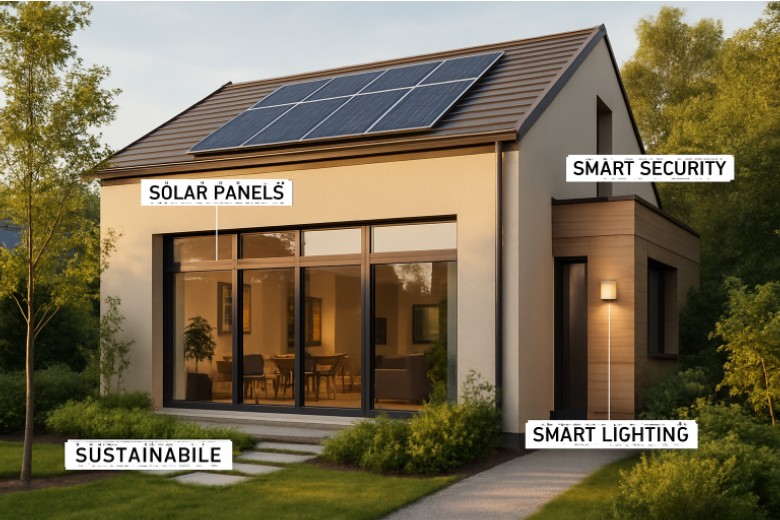Residential construction is undergoing a transformation, with groundbreaking innovations and design philosophies reshaping how we build and experience homes. Today’s homeowners are demanding more than just stylish spaces—they’re looking for intelligent, adaptable, and sustainable environments that can grow with their changing needs. LaGrange real estate experts The Vitell Group have witnessed firsthand how these emerging trends are being woven into the local market to offer residents a new standard in comfort and functionality. New standards for residential living are pushing builders to integrate the best in technology, design, and construction practices. The drive for energy efficiency, wellness, and flexibility is no longer just a trend—it’s a fundamental shift in what defines a desirable home. These developments are elevating both the livability and long-term value of today’s residential properties as buyers seek homes that deliver on quality of life, sustainability, and ease of use. By focusing on these advancements, developers and homeowners alike are benefiting from homes that better meet everyday requirements while also preparing for a more efficient and connected future.
Smart Home Integration
Smart home technology is seamlessly weaving itself into the fabric of residential construction. With the touch of a button or the sound of a voice command, homeowners can now manage everything from lighting and security cameras to climate settings and entertainment systems. Innovations such as learning thermostats, automated lighting, and integrated security systems have given rise to homes that are more secure and efficient than ever before. Beyond luxury, these features offer ways to reduce energy bills, minimize the home’s carbon footprint, and even increase property values. Investing in smart home tech is quickly moving from novelty to necessity for many buyers.
Flexible Living Spaces
As families’ needs evolve, so do home layouts. The open-concept trend is being expanded to include multipurpose spaces that can serve different roles as needed—one day a home office, the next a guest suite, playroom, or gym. Sliding doors, movable partitions, and modular furniture allow homeowners to reconfigure rooms easily, maximizing the usability of every square foot. This adaptability addresses both the needs of remote work and the desire for homes that can cater to different phases of life, making flexibility a top priority for new builds and renovations alike.
Sustainable Building Practices
The drive to “build green” is reshaping residential construction through the use of energy-efficient systems, low-impact materials, and earth-friendly strategies. Energy Star-rated appliances, high-performance windows, and solar panels are fast becoming standard features. Builders are also prioritizing smart water management, eco-friendly insulation, and air-tight building envelopes that reduce energy loss. Green roofs and rainwater harvesting systems further enhance sustainability efforts. These choices help save homeowners money while also reducing a home’s environmental footprint, as highlighted by Architectural Digest.
Biophilic Design
The principles of biophilic design—a movement aimed at strengthening the connection between people and nature—are making their way into residential projects of all sizes. Large windows, green walls, indoor gardens, and strategically placed skylights flood interiors with natural light and create calming green oases even in the heart of the city. Outdoor living spaces, balconies lined with planters, and community gardens are now essential features in many developments, providing residents with accessible spaces to recharge and connect with the outdoors. Studies show that homes with biophilic features can help lower stress and boost well-being.
Innovative Materials and Construction Methods
Innovations in residential building materials and practices are opening up new possibilities for architects and homeowners alike. The adoption of mass timber—engineered wood that is as strong as steel and significantly more sustainable—marks a major breakthrough. Materials like graphene are also being tested in residential settings for their unmatched durability and flexibility. Rapid advances in 3D printing and modular construction methods are reducing costs and project timelines, making custom homes more accessible while slashing waste. These advancements not only offer durability and design freedom but also further the goal of low-impact, scalable construction solutions.
As the expectations placed on residential spaces shift, the construction industry continues to innovate to meet those demands. The fusion of technology, sustainability, and nature-driven design is shaping neighborhoods that prioritize health, convenience, and adaptability. These trends aren’t just about the aesthetics—they’re about turning every new home into a haven that serves its residents’ needs for years to come.
Conclusion
Residential construction is no longer just about creating shelter—it’s about crafting intelligent, sustainable, and life-enhancing environments. From smart technology and flexible layouts to eco-conscious building practices and nature-inspired design, today’s homes are redefining what it means to live well. With innovative materials and construction methods pushing the boundaries of possibility, the future of housing promises to be more connected, adaptable, and resilient than ever before. For buyers, builders, and communities alike, these advancements signal an exciting new era in residential living—one where homes are designed not only for today but for generations to come.
